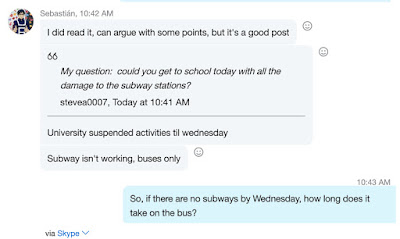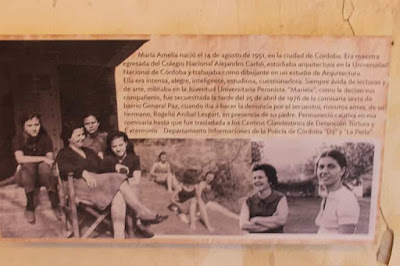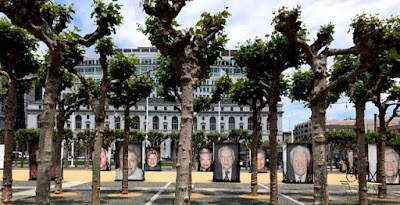This a follow up to yesterday's post on Chile's protests and government response. It's based on a Skype chat with Sebastían, my college student friend in Santiago. He was the catalyst for yesterday's post. I'll use some images of the Skype chat to give a sense of this 'interview' but I've abbreviated it somewhat to cut out repetition and side conversations. I've made the images as big as I think I can fit them here. You may have to work a bit to read them, but the visual of the chat seemed to capture our chat better than just the words.
I began by letting him know I'd posted about our previous chat (he'd said it was ok), about the protests, whether he had any comments, (he did) and by asking how he got to school today if the subway stations were damaged.
[Note: OCDE - mentioned below- is Spanish initials for OECD (Organisation for Economic Co-operation and Development ]

Let's look at that picture of crowd for a subway train in Santiago at peak time a little larger.
Also, some clarification - "minimum salary is 300,000 clp (Chilean pesos). 300,000 clp would be (today) $413. That's per month. Here's a chart from wage indicator.org that shows 300,000 clp is below what a single person needs to live.
 |
| Data for Chile Sept. 2019 - From wage indicator.org |
Let's catch up a bit. First he sent me to an instagram that shows Chile's current president Pinera saying "Estamos en guerra" or "We are at war." Then it shows president Pinochet saying almost the exact same words 30 years ago. [I couldn't figure out how to get the GIF from Instagram to here (this is just a screenshot, but if you click on the image below, it will take you to the GIF.]

And an Instagram response:
Then he sent me to this video on Twitter, shot from a window above, of police or military, who could be snorting coke. Or not. You can judge for yourself.
PACOS JALANDO! pic.twitter.com/lByZsJcXo8— gonzalosoyyo 👑 (@gonzalosoyyo) October 20, 2019
And this video Esto pasa en Chile - This is happening in Chile. It begins with the president saying we are in war. Then it has shots of the police attacking citizens. Some particularly troubling ones include police cars intentionally running over people fleeing.
There is so much conflict around the world now:
It's easy to not pay attention to what's happening in Chile. But one of the Instagram sites Sebastían sent me to had this message:
"Friends of the world TV is not going to show this, help us to make visible. THE POLICE AND THE MILITARY ARE KILLING PEOPLE!"
Which included this:
"KNOW THAT IN CHILE TODAY, OCTOBER 2019 THE PEOPLE TIRED AND THE PIÑERA GOVERNMENT IS REPRESSING IT WITH DEATH, THE SAME AS IN THE PINOCHET DICTATORSHIP.."
[Translations from Google Translate. Overall it's a messy translation so that's all I'll offer.]
Here's the Spanish from the Instagram, but I can't seem to get the link right on my Mac - it works on my phone.
- Hong Kong
- Kurds in Syria
- The British are in knots over Brexit
- Venezuela
- Yeman
- Refugees in camps around the world
- US president facing impeachment
It's easy to not pay attention to what's happening in Chile. But one of the Instagram sites Sebastían sent me to had this message:
"Friends of the world TV is not going to show this, help us to make visible. THE POLICE AND THE MILITARY ARE KILLING PEOPLE!"
Which included this:
"KNOW THAT IN CHILE TODAY, OCTOBER 2019 THE PEOPLE TIRED AND THE PIÑERA GOVERNMENT IS REPRESSING IT WITH DEATH, THE SAME AS IN THE PINOCHET DICTATORSHIP.."
[Translations from Google Translate. Overall it's a messy translation so that's all I'll offer.]
Here's the Spanish from the Instagram, but I can't seem to get the link right on my Mac - it works on my phone.
que nosotrxs no lo vivimos, nosotrxs lo estamos viviendo. Amigxs del mundo la tv no va a mostrar esto, ayudenos a visibilizar. LA POLICÍA Y LOS MILITARES ESTÁN MATANDO GENTE! DESPUÉS DE UNA SEMANA DE MANIFESTACIONES DETONADAS POR EL ALZA EN EL TRANSPORTE PÚBLICO, QUE INVOLUCRARON LA EVASIÓN EN EL PAGO DEL MISMO, INFILTRADOS EN LAS MANIFESTACIONES COMIENZAN A REALIZAR MONTAJES TANTO DE INCENDIOS, BARRICADAS COMO DE SAQUEOS, PARA ASÍ EL INCOMPETENTE QUE TENEMOS POR PRESIDENTE, TENER EXCUSAS PARA DECLARAR UN TOQUE DE QUEDA Y SACAR A LOS MILITARES A LA CALLE VELANDO POR "EL ORDEN PÚBLICO" QUE SUS MISMOS PERKINES HAN DESTRUIDO EN BASE A MONTAJES. HOY ES EL 3ER DÍA Y YA HAY FALLECIDOS Y GENTE DESAPARECIDA. QUE SE SEPA QUE EN CHILE HOY, OCTUBRE DE 2019 EL PUEBLO SE CANSÓ Y EL GOBIERNO DE PIÑERA ESTÁ REPRIMIENDOLO CON MUERTE, IGUAL QUE EN LA DICTADURA DE PINOCHET. .HERMANX QUE ESTÁS AQUÍ SI TE TOMAN #DITUNOMBRE GRITALO! Y QUE APAREZCAN TODXS LXS QUE HOY NO ESTÁN! ..NO QUEREMOS MÁS MUERTES NI MÁS DESAPARECIDXS. NO QUEREMOS TU MIERDA DE DOCTRINA DE SHOCK!!! FOTO: CONCEPCIÓN @afpphoto
















































